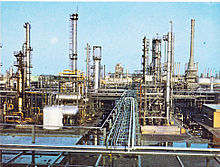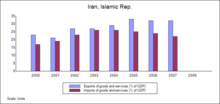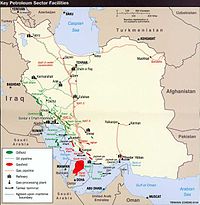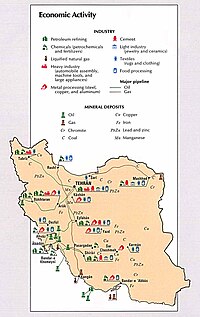|
Foreign direct investment in Iran
 Foreign direct investment in Iran (FDI) has been hindered by unfavorable or complex operating requirements and by international sanctions, although in the early 2000s the Iranian government liberalized investment regulations. Iran ranks 62nd in the World Economic Forum's 2011 analysis of the global competitiveness of 142 countries.[1][2] In 2010, Iran ranked sixth globally in attracting foreign investments.[3] Foreign investors have concentrated their activity in a few sectors of the economy: the oil and gas industries, vehicle manufacture, copper mining, petrochemicals, foods, and pharmaceuticals. Iran absorbed US$24.3 billion of foreign investment from 1993 to 2007 and US$34.6 billion for 485 projects from 1992 to 2009.[4][5] Opening Iran's market place to foreign investment could also be a boon to competitive multinational firms operating in a variety of manufacturing and service sectors, worth $600 billion to $800 billion in new investment opportunities over the next decade.[6][7][8][9] FDI statisticsCountriesFirms from over 50 countries have invested in Iran in the past 16 years (1992–2008), with Asia and Europe receiving the largest share, as follows:[10]
SectorsAs of 2007, Asian entrepreneurs made the largest investments in the Islamic state by investing in 40 out of 80 projects funded by foreigners.[11][12] The largest amount of foreign investment was in the industrial sector, including food and beverage, tobacco, textiles, clothing, leather, chemical, steel and oil derivates. The figure exceeded US$8.76 billion. Water, electricity and gas sector ranked second, attracting $874.83 million. In the third place, the real estate sector absorbed more than $406 million. Investments in service, telecommunication, transportation and mines reached $193 million, $14.3 million and $14.2 million respectively. Asian countries invested $7.666 billion in various projects followed by several multinational consortia. Investments by these multinational companies exceeded $1.39 billion (in four projects). Although European entrepreneurs were involved in 34 projects, they invested only in the range of $1.2 billion in the Islamic Republic. American countries also committed $12.329 million in the country; while investments by African states registered close to $4 million.[11] Amounts Stock of FDI in Iran equaled $16.82 billion (at home) and $2.075 billion (abroad) according to The World Factbook statistics in 2010.[14] According to the United Nations Conference on Trade and Development (UNCTAD), foreign direct investment (FDI) in Iran hit a new record in 2010 and surpassed 3.6 billion dollars despite sanctions imposed on the Islamic Republic.[15] The EIU estimates that Iran's net FDI flow will rise by 100 per cent within the next four years (2010–14).[16] The Economist estimates that FDI (net inflow) in Iran was $1.4 billion in 2011 (equivalent to 0.3% of GDP) down from $3.2 billion in 2010. The report forecasts this figure for 2012 to fall to $1.25 billion, but increase again for the next 3 years and to reach $1.8 billion in 2015.[17] The Government of Iran says planned FDI in 2011 was $4.3 billion and planned FDI will reach $8–10 billion in 2012–13.[13] However, UNCTAD later reported that FDI inflow in Iran was $3.05 billion in 2013, while Iran's FDI in other countries (i.e. outflow FDI) was $380 million.[18] Bushehr province and Khuzestan province enjoy the highest volume of foreign investment which mostly goes for oil and gas sectors. In 2012, the provinces of Fars, Gilan, Tehran, Kerman, Mazandaran and West Azerbaijan ranked first to sixth place in attracting foreign investment in the country.[13] According to the government of Iran, Iran needs up to $300 billion in foreign direct investment to meet the objectives of its Five-Year Economic Development Plan (2010–2015), and reach eight percent economic growth rate.[19] Turning to "Vision 2025", the plan has set an investment target of $3.7 trillion within two decades (2005–2025) of which $1.3 trillion should be in the form of foreign investment.[20] CompaniesThe Organization for Investment, Economic and Technical Assistance of Iran (OIETAI) is responsible for receiving and processing all foreign investment applications. OIETAI is also responsible for approving overseas Iranian investments. In other words, the organization is in charge of consolidating and implementing two-way foreign investment flows. According to Iranian President Rouhani cooperation with Iran is on the condition that foreign companies participate in joint investments, technology programs, and exporting from Iran.[21] As at 2012, 400 foreign companies are directly investing in Iran.[22] Among developed nations, the most active investors have been Germans, Norwegian, British, French, Japanese, Russian, South Korean, Swedish, and Swiss companies. The Swedish Svedala Industri has played a major role in developing Iran's copper mines since the late 1990s while Tata Steel of India has been investing in the steel sector. The Kia, Nissan, Peugeot, and Renault of France auto companies have licensing agreements with Iranian auto manufacturers. Danone of France, Nestlé of Switzerland and Coca-Cola and PepsiCo of the United States have joint ventures with Iranian companies. TotalEnergies, Equinor, Shell, Gazprom, and LG of South Korea have been active in Iran's natural gas industry. Iran's constitution prohibits direct concession of petroleum rights to foreign investors. Alcatel of France, MTN Group of South Africa and Siemens of Germany gained major telecommunications contracts in 2004 and 2005, respectively.[23][24]
The Wall Street Journal (July 2014)[9]
Front menIn 2015, The Economist and The Wall Street Journal reported that American companies (incl. Apple Inc. and Hewlett-Packard) are using local (Iranian) front men to seal deals in Iran. In the oil and banking business some "prime contracts" have already been signed while Iran is still under "international sanctions".[25][26] Boeing, Microsoft, Siemens, BP, Chevron, Gazprom, Eni, Samsung, Renault. Peugeot, GM are also returning to Iran.[27] Economic profileBusiness environment According to United Nations Conference on Trade and Development, Iran ranked sixth globally in 2010 in attracting foreign investments.[3] According to the head of the Organisation for Investment, Economic and Technical Assistance of Iran (OIETAI), in 2008 Iran ranked 142 among 181 countries in terms of working conditions last year. Iran stands 96 in terms of business start, 165 in getting permits, 147 in employment, 147 in registering assets, 84 in getting credits, 164 in legal support for investments, 104 in tax payment, 142 in overseas trade, 56 in feasibility of contracts and 107 in bankruptcy.[28] Iran is a member of the World Bank's Multilateral Investment Guarantee Agency.[29] Iran ranks 69th out of 139 in Global Competitiveness Report.[1] Iran has more than 50 signed-bilateral investment treaties with other countries.[30] Natural resourcesIran holds 10% of the world's proven oil reserves and 15% of its gas. It is OPEC's second largest exporter and the world's fourth oil producer. Iran is OPEC's second largest oil producer. It has approximately 9% of world oil reserves (some 94 billion barrels). It has the second largest reserves of natural gas in the world at some 812 trillion cubic feet. Iran is considered an energy superpower. Iran also possesses enormous mineral resources, including coal, copper, iron, zinc and gold. This has spawned a number of processing industries, particularly steel. Iran is already the third largest producer of copper in the world. Competitive advantagesIran has made the development of non-oil exports a priority. The country has the advantage of a broad domestic industrial base, technology an educated and motivated workforce, cheap labor and energy resources and geographical location, which gives it access to an estimated population of some 300 million people in Caspian markets, Persian Gulf states and countries further east.[31] Iran has the consumer potential of Turkey, the oil reserves of Saudi Arabia, the natural gas reserves of Russia, and the mineral reserves of Australia.[32] Iran's area roughly equals that of the United Kingdom, France, Spain, and Germany combined.[33] Iran has a diverse climate which makes it suitable for a wide range of agricultural products.[34] Laws concerning foreign companiesGenerally speaking, Iran has two types of laws concerning foreign companies. The first are laws that address issues concerning foreign companies directly such as the Foreign Investment Promotion and Protection Act (FIPPA) and the second are general laws of which certain articles or by-laws address foreign companies, for instance the Taxation Law and the Labor Law. Iran's environment is protected by strict laws and the Department of the Environment is in charge of evaluating the impact of the projects and their monitoring. General laws and regulations regarding foreign business in Iran could be regrouped under the following categories:[35]
Investment by natural persons of foreign nationalityIn 2006, Iranian citizens abroad's net worth was $1.3 trillion.[38] In 2000, the Iran Press Service reported that Iranian expatriates had invested between $200 and $400 billion in the United States, Europe, and China, but almost nothing in Iran.[39] In Dubai, Iranian expatriates have invested an estimated $200 billion (2006).[40] According to the Civil Code, foreign nationals will, subject to the existence of a treaty on reciprocity, enjoy the same rights and privileges of Iranians. The companies formed by such foreign nationals will be of Iranian nationality and subject to the same laws which regulate the activities of Iranian companies. Foreign investment in the framework of the Commercial CodeThe Iranian Commercial Code is divided into four parts:
Foreign nationals can, in the framework of the Commercial Code and subject to the observance of the relevant procedures, form and register companies in Iran. Iran's Commercial Code does not differentiate between Iranian and foreign stock holders of Iranian companies. In other words, there is no restriction regarding the nationality of those who want to establish companies in Iran. In this context, foreign exchange restrictions are equally applied to Iranian and foreign investors. Such companies, however, do not enjoy the privileges set out in FIPPA (see below). Company typesThere are seven types of juridical entity or company which can be established under the Iranian Commercial Code as follows:[41]
From among all these different types, joint-stock company, in which the capital is divided by shares, is the most common and acceptable type of company which can be recommended to foreign investors.[42] FIPPAProvisions of the 2002 Act entitled Foreign Investment Promotion and Protection Act (FIPPA) include:[35]
For the first time, project financing schemes such as buy back agreements and BOT projects (only under an operator status) are specifically covered under the foreign investment law.[44] Under the FIPPA, any foreign natural or legal person importing capital in Iran will enjoy the benefits and privileges of this law as long as:
Starting in 2014, foreign investors, who establish production lines in Iran and export 30 percent of their products, will be entitled to tax exemptions (up to 50%).[45][46] Potential approaches to the marketFirst and foremost, it is crucial to realize that Iranian authorities insist on a long-term commitment and a transfer of technology as a requisite for getting a share in the market. Foreign companies are therefore advised to adopt a medium- to long-term strategy for the Iranian market. Iran will almost never honor the interests of a company that does not show long-term commitment. Tenders are strictly required for government contracts for purchasing or projects. These are rarely competitive. Breaking up contracts into smaller parts is a common practice to try to incorporate at least 30% of the contract's value in local capability and also to negotiate on specific prices. Currently there are three main routes that a foreign company can follow to establish a long-term presence in Iran: Joint ventures
Should a company decide to adopt this approach to the market, it is advisable to look for products and services that have both domestic demand as well as regional export potential. If a joint-venture company can earn hard currency through export of its goods, it will not be too dependent on the Iranian banking system for the repatriation of profits and dividends. Some joint ventures consist purely of the transfer of technology to Iran by the foreign partner without any capital commitment. Since Iranian authorities are very keen on the introduction of modern technologies, this path can prove very constructive. In August 2010, the 25% ceiling set for joint venture companies in enjoying facilities from the foreign exchange reserve account has been eliminated.[47] Industry and mines, agriculture, transport, services (such as tourism), IT and the export of goods and services are the sectors authorized to enjoy the new facilities from the Foreign Exchange Reserve Account.[48] Buy-back In the 1990s and early 2000s, some indirect oilfield development agreements were made with foreign firms. Buyback contracts in the oil sector, for instance, were arranged in which the contractor funded all the investments, and then received remuneration from the National Iranian Oil Company (NIOC) in the form of an allocated production share, then transferred operation of the field to NIOC after a set number of years, at which time the contract was completed. In February 2007 the government unveiled its new buyback-contract formula, which significantly extended the length of the contracts to as long as 20 years.[49] The buy-back scheme is a formula used by the Iranian government to attract foreign investment. Following the end of the Iran–Iraq War in 1988, Iran faced a major problem: it needed foreign investment if it did not want to lose its vital income from the oil and gas industry, yet its revolutionary ideology and Constitution forbid granting "concessions". A compromise solution was found in 1989 with the First Five-Year Economic, Social and Cultural Development Plan. Under Note 29 of the said plan, the Iranian government is allowed to employ "buybacks" in its effort to meet the industrial and mineral needs in connection with exports, production and investment. Put in laymen terms, a buy-back transaction is a method of trade where plants, machinery, production equipment and technology is supplied (by a domestic or foreign private firm), in exchange for the goods that will be produced directly or indirectly by means of such facilities.[43] Under this scheme, the foreign partner that makes the initial investment can repatriate the return on the investment (at a pre-agreed fixed rate) through goods and services produced by the project.[citation needed] While many foreign companies believe that this method is a mere financing instrument for Iran, it is more accurate to say that it is a compromise formula for foreign investment in the short-run. In the medium to long-term, more appropriate laws and regulations will probably replace the buy-back scheme. In other words, once the constitutional concerns have been dealt with, the foreign partners of buy-back agreements can take over the projects that they are involved in, or they can enter into a joint venture with an Iranian partner.[43] The Iranian (or Integrated) Petroleum Contract (IPC)Some of the main criticisms of the buyback contracts include lack of flexibility of cost recovery and in some cases, the NIOC's limited expertise to reverse field decline rates in comparison to the International Oil Company (IOC) that developed the field. The Integrated Petroleum Contract (IPC) will require the IOCs to fulfill Iran's local content requirement, which will be 51% of the contract and transfer of technology.[50] IPCs will be offered for work on somewhere between 34 and 74 oil fields and could last for the duration of a field's life.[51] In 2013 Iran also announced for the first time since the Iranian revolution of 1979, the offering of production sharing contracts (PSCs) for the most complicated and difficult projects, such as deep-water wells in the Caspian Sea (the details of which will be revealed in December 2015 in London).[51][52][53] Build-Operate-Transfer (BOT)Recent regulations have introduced the Build–operate–transfer (BOT) scheme for Iranian projects. This is a rather new possibility in the Iranian market. In this scheme, the foreign partner invests in one project, which is then operated for a certain period of time by the foreign investor before it is fully transferred to the Iranian government. Iranian authorities are showing some flexibility regarding the BOT, which could potentially pave the way for more foreign investment in the market.[43] Free trade zones and special economic zones Iran's interest in free zones can be traced back to the 1970s.[54] AdvantagesFree-trade (FTZ) and special economic zones (SEZ) have been established to provide additional investment incentives such as:
LocationsAs of January 2010, there were six free-trade zones (FTZ) and 16 special economic zones (SEZ) in Iran.[55] More FTZ and SEZ are planned in Iran.[56] Outward FDIIran has made substantial investments abroad. The main agencies in charge are the Iran Foreign Investments Company (FDI) and the Central Bank of Iran (Forex). Broadly speaking, these investments can be categorized as FDI and foreign portfolio investments: Outward FDI include:
Portfolio investments include:
Partial ownership in:
Besides, Iranians citizens and Iranian citizens abroad, as individuals, have made substantial investments in Dubai (e.g. real estate, trading companies) and hold significant portfolio investments in various companies throughout Europe, China and the United States. Wealthy Iranians, companies and state-backed buyers will invest up to $8.5 billion in overseas real estate over the next five-to-10 years (2016).[57] See also
References
Bibliography
External links
|



